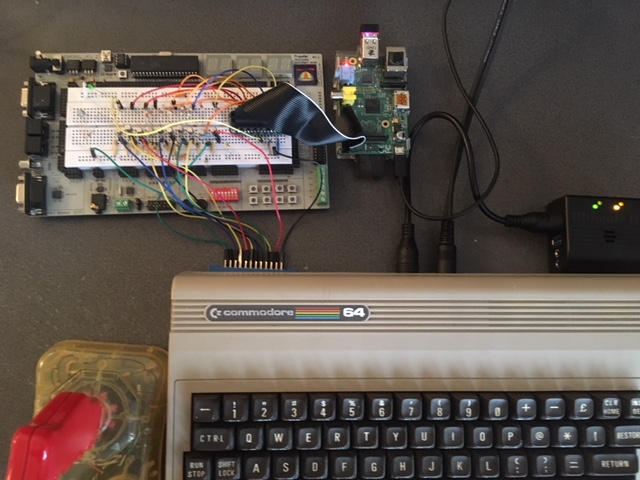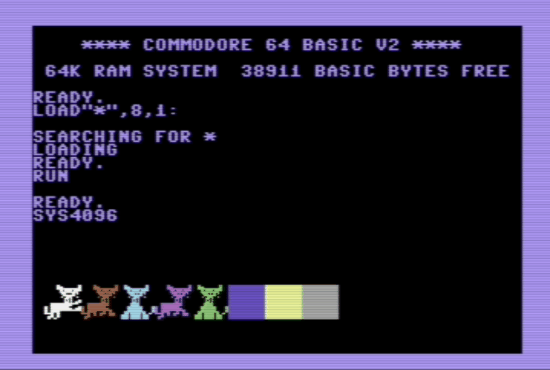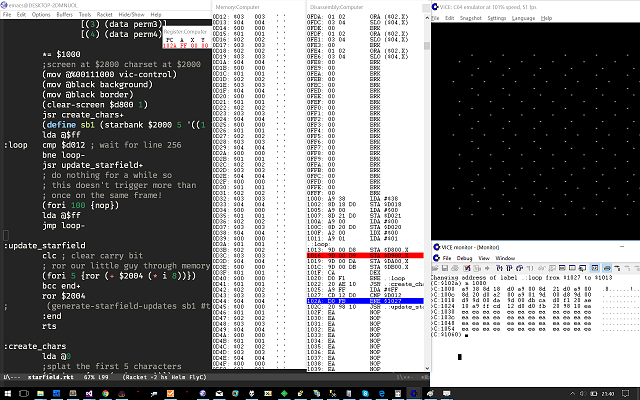Posts tagged C64
In this post I will describe a small electronics project designed to enable the remote programming of a real Commodore 64 that is switched on and running. To achieve this, several parts are involed, utilising some custom circuitry and communications protocol, a Raspberry Pi, a C program, a 6502 assembler program and a little F# program to finish it off.
In this post we will see how asi64’s (Racket’s) macro system can massively reduce the amount of 6502 assembly code you have to write, beyond what a typical macro assembler can achieve.
In this post we will see how asi64 is more than your average macro assembler, by combining arbitrary disk io, functional programming techniques and code generation alongside your typical 6502 assembly code. The aim is to create a very simple sprite animation viewer, that writes the resulting C64 program by interleaving file parsing and machine code generation.
Here’s the program displaying some sprites that @silverspoon has started working on :) (in different, single colours for the fun of it)
In my last few posts, I detailed some of my experience learning 6502 assembler for the Commodore 64. I started off using DASM, which seems to be quite a nice assembler, severely lacking in documentation. Then I discovered the very awesome KickAssembler, which includes a full blown scripting language on top of java, lots of other very nice features, and great documentation. This made me realise what a powerful modern assembler could be like - and perhaps I could go one step further with it.
Asi64 extends Racket to become a 6502 assembler. No need for scripting languages or half baked macro systems here - you have literally all of Racket and its amazing macro system on your side. It also has direct support for Vice, a popular Commodore 64 emulator, passing your labels and breakpoints along enabling a fluid programming and debugging cycle. Hats off to the fantasic KickAssembler, I have stolen many ideas from it :)
In the last post we discovered how to decode 15-bit symmetric invaders into a chacrater set. This time around we will make them fractal!
The invaders from the last post occupy exactly one character each. The aim is to now select an invader at random, and then draw it one size bigger, using other random invaders as its “pixels” like this
Then, the process can be repeated again, drawing an even bigger invader which is formed by drawing even bigger “pixels” which are composed of the size 2 invaders, like this!
I have recently been getting into programming the Commodore 64. It’s lots of fun to work in such a restricted environment, where you have to use various hardware tricks to achieve your goals. Every machine cycle and byte of memory counts!
I have not programmed in 6502 assembler or the C64 before. I am using the popular C64 emulator WinVice and an assembler called DASM. Having messed around a bit and learnt the basics of the instruction set and the hardware/memory layout, I programmed a couple of effects such as the basic text scroller. I have an idea in mind for my first demo, and part of it revolves around the invader fractal. I have implemented this in various langauages (F# and D being the most recent) and figured it would be a nice fit for the C64.
Invaders
The invader fractal is a very simpe idea, based on the observation that the classic space invaders are symmetrical. Given a 5x5 grid, we can observe that the middle column is static, whilst columns 4 and 5 are columns 1 and 2 flipped around:
This means we can store the information for each row in just 3 bits, multiplied for each row gives us 15 bits to encode an entire invader. 15 bits gives a total of 2^15=32,768 unique invaders. “Real” space invaders are a little bit bigger than 5x5, but we will stick with their smaller cousins.





